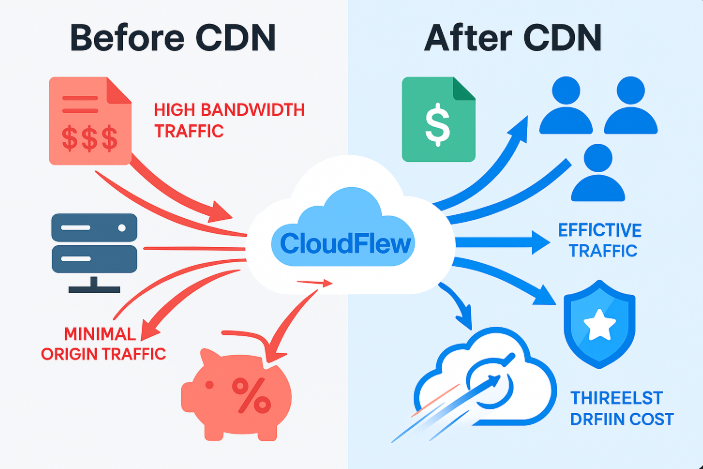
Is your website's success story being overshadowed by eye-watering server bills? As your traffic grows, bandwidth consumption often becomes one of the largest and most unpredictable operating expenses, directly eating into your profits or budget. It’s a common headache, but it doesn't have to be an unavoidable consequence of growth.
There's a powerful tool specifically designed to combat this: the Content Delivery Network (CDN). While often praised for speeding up websites, a CDN's ability to drastically cut origin server bandwidth costs is arguably one of its most significant financial benefits. This guide provides practical steps on how you can leverage a CDN to slash those server bills, potentially saving 70% or more on bandwidth expenses.
Understanding the Bandwidth Drain: Why Costs Escalate
First, let's quickly recap why bandwidth costs can spiral. Bandwidth refers to the amount of data transferred from your primary web server (the "origin server") to your visitors' browsers. Every image, video, script, stylesheet, and even the HTML page itself contributes to this data transfer.
The main culprits behind high bandwidth usage are typically:
Large Static Files: High-resolution images, videos, large JavaScript libraries, CSS files, downloadable assets, etc.
High Traffic Volume: More visitors mean more downloads of these assets.
Inefficient Serving: Without a CDN, every user, regardless of their location, fetches all website assets directly from your origin server, leading to massive, repetitive data transfers.
The CDN Solution: Offloading Traffic from Your Origin
A CDN fundamentally changes this dynamic by acting as an intermediary distribution layer. Its core principle is simple yet incredibly effective:
Caching: CDNs maintain a network of servers (edge nodes) distributed globally. They store copies (cache) of your website's static files on these edge servers.
Edge Delivery: When a user requests your site, the CDN intelligently directs them to the nearest edge server. If that server has the requested static file cached (like an image or CSS file), it delivers it directly to the user.
The crucial point for cost saving is this: Data served from the CDN edge cache does not consume bandwidth from your origin server. Since static files often constitute 70-90% of a typical website's total data size, offloading their delivery to the CDN means your origin server only needs to handle a fraction of the original data transfer volume. This directly translates into massive potential savings on your server bandwidth bill.
Practical Steps to Maximize Bandwidth Savings with CDN
Simply turning on a CDN helps, but strategic configuration maximizes your savings. Here are four key steps:
Step 1: Identify and Cache Your Static Assets Aggressively
This is where the most significant savings come from. Ensure your CDN is configured to cache all appropriate static content. Action: Review your CDN settings. Define rules (based on file extension like .jpg, .png, .css, .js, .mp4, .pdf, or specific directory paths) to tell the CDN which assets are static and cacheable. Benefit: Offloads the vast majority of data transfer away from your expensive origin server bandwidth. Regularly check your CDN analytics for the "cache hit ratio" – a higher ratio means more content is being served from the cache, maximizing savings. Implementation Notes: Providers like CloudFlew, utilizing robust global networks such as AWS, typically offer intuitive control panels to easily set up caching rules and ensure broad coverage for effective asset offloading.
Step 2: Optimize Cache Durations (TTL Settings)
Setting how long content stays cached on edge servers (Time-To-Live or TTL) is important. Action: Configure appropriate TTLs for different types of content. Benefit: Longer TTLs for files that rarely change (like your logo, core CSS files, font files) reduce the frequency with which CDN nodes need to check back with your origin server to see if the file has been updated (a process called revalidation). This saves small amounts of origin bandwidth and keeps your cache hit ratio high. Shorter TTLs are suitable for files that might change more often. Implementation Notes: Balance the need for content freshness with caching efficiency. Most CDN dashboards allow setting default TTLs and overriding them based on file type or path.
Step 3: Leverage Smart Caching Techniques (Beyond Static Files)
You can sometimes cache more than just purely static files.
Action: Explore options for short-term caching of semi-dynamic content and utilize HTTP cache validation headers.
Benefit: Even caching things like API responses or specific HTML pages (like blog posts) for a few minutes can significantly reduce origin load and bandwidth during traffic spikes. Properly configured ETag or Last-Modified headers allow origin servers to respond with a tiny "304 Not Modified" message instead of resending the whole file if the content hasn't changed, further saving回源 (origin fetch) bandwidth.
Implementation Notes: This requires a good understanding of how often your content updates. Use CDN features like Cache-Control and Vary headers effectively. Ensure you know how to quickly purge (invalidate) cache when content does change. Look for CDNs offering flexible cache rule engines.
Step 4: Utilize Bundled CDN Features for Indirect Savings
Often, the total value of a CDN package extends beyond just traffic offloading. Action: Evaluate the features included with your CDN service. Benefit: You might be able to consolidate costs by using bundled features instead of paying for separate services. Common examples include: DDoS Protection: Many CDNs, including CloudFlew, offer baseline DDoS mitigation, potentially saving you the cost of a dedicated security service. SSL Certificates: Easy deployment, management, or even free SSL options (like CloudFlew's free SSL acceleration) bundled with the CDN can save significant money and hassle compared to managing certificates independently. Performance Optimizations: Some CDNs offer basic image or code optimization at the edge, possibly reducing reliance on other tools. Implementation Notes: Consider the total cost of ownership. The value of bundled features can often make a slightly higher-priced CDN package more economical overall.
Choosing a CDN Provider for Cost Savings
When your primary goal is reducing bandwidth costs, focus on these aspects when choosing a provider:
Transparent & Competitive Pricing: Low per-gigabyte traffic costs are paramount. Understand the pricing structure (global flat rate vs. regional, request costs, etc.) and ensure there are no hidden fees. Effective Caching Features: The CDN must provide flexible and easy-to-use controls for cache rules, TTLs, and purging to effectively implement the savings strategies. Valuable Bundled Features: Assess the real-world savings provided by included extras like DDoS protection and SSL handling. Good Analytics: You need clear reporting to monitor your cache hit ratio and confirm the actual reduction in origin bandwidth usage.
Providers like CloudFlew aim to hit a sweet spot, combining competitive pricing models (like their advertised low per-GB rates) with essential bundled features (DDoS protection, SSL acceleration) and reliable, extensive infrastructure (like the AWS backbone), offering a compelling value proposition for businesses focused on optimizing costs.
Conclusion: Take Control of Your Bandwidth Costs
Skyrocketing server bandwidth bills don't have to be an inevitable part of website growth. By strategically implementing a Content Delivery Network and focusing on maximizing its caching potential, optimizing cache settings, and leveraging its full feature set, you can achieve dramatic and sustainable cost reductions.
Take the steps outlined in this guide: aggressively cache your static assets, fine-tune your TTLs, explore smart caching, and utilize bundled value. Choose a CDN provider, like CloudFlew, that empowers you with the right tools, pricing, and features to make these savings a reality. Analyze your usage, evaluate your options, and start slashing those server bills today!

